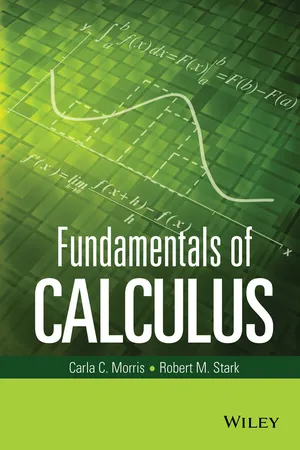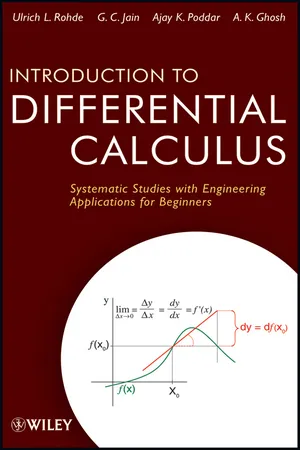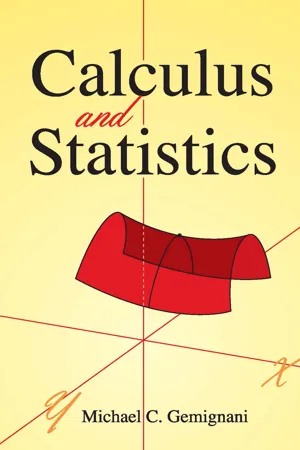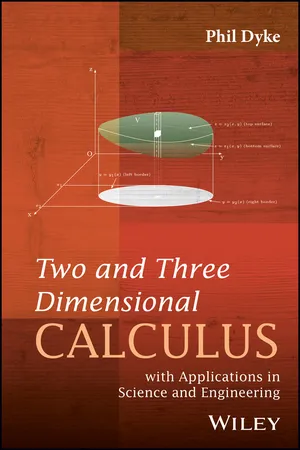Mathematics
Maxima and Minima
Maxima and minima refer to the highest and lowest values of a function, respectively. In calculus, finding these points is important for optimization problems, where the goal is to find the maximum or minimum value of a function within a given range.
Written by Perlego with AI-assistance
Related key terms
Related key terms
1 of 4
Related key terms
1 of 3
4 Key excerpts on "Maxima and Minima"
- eBook - ePub
- Carla C. Morris, Robert M. Stark(Authors)
- 2015(Publication Date)
- Wiley(Publisher)
extrema.The absolute maximum of a function, on the other hand, is the largest value the function assumes over its domain. If it becomes infinite, the maximum is unbounded. Likewise, the absolute minimum of a function is its smallest value over its domain. Absolute Maxima and Minima may also have horizontal tangents and, in a sense, are local as well as absolute. Absolute extrema have functional values that are greater or lesser than any other extrema a function may have.Usually, an absolute maximum (minimum) occurs at a local extremum. Sometimes, it occurs at an endpoint of the domain or when restrictions are placed upon the function, for example, that x must be positive valued as in many applications or when a function is defined only in the first quadrant. When the maximum (minimum) occurs at an endpoint, it is called an endpoint extremum and it lacks a horizontal tangent.The following example is illustrative of these concepts.Example 3.1.1 Identifying Extrema
- Identify increasing and decreasing intervals of the function. Also, identify extrema (local, endpoint, and absolute).
.
Solution:
The function increases on the intervals ( ) and (0, 1). It decreases on ( ) and (1, 2).There are two local maxima: at and (1, 6). A local minimum exists at (0, 4).There is an endpoint minimum at (2, 3) (signified by the closed endpoint.)Here, the local maximum at is also the absolute maximum of the function.The absolute minimum of the function is unbounded as x decreases through negative values.Concavity and Inflection
A function whose graph is “concave up” can “hold water.” A graph that is “concave down” “spills water.” Respective sketches appear as follows..Where concavity changes from “up to down” or vice versa, an inflection point is said to occur as shown in the following example.Example 3.1.2 More on Identifying Extrema
Indicate where the following function increases, decreases, and has extrema. Also indicate where the function is concave up, concave down, and identify any inflection points. - eBook - ePub
Introduction to Differential Calculus
Systematic Studies with Engineering Applications for Beginners
- Ulrich L. Rohde, G. C. Jain, Ajay K. Poddar, A. K. Ghosh(Authors)
- 2012(Publication Date)
- Wiley(Publisher)
greater than the maximum of the function at x = x 1 .Figure 19b.1At this stage, we introduce the following terms and concepts that will be frequently used in this chapter.- Absolute Maximum (Minimum) of a Function : In Figure 19b.1 , note that at x = b , the value of the function is greater than any maximum of the function on the interval [a , b ]. Thus, the greatest value of the function occurs at x = b , and similarly, the smallest value occurs at x = x 2 . We say that the absolute maximum of f is f (b ) and the absolute minimum is f (x 2 ).
- The Points of Extreme Values of a Function : The points like x 1 , x 2 , x 3 , x 4 , and b at which the extreme values of the function f occur , are called the points of extremum (or extreme) values of the function. Note that, a function defined on an interval can reach maximum and minimum values only for the points that lie within the given interval .1
Our interest lies in finding the points of extreme values of a continuous function by using the concept of the derivative . Once such points are known, it is easy to compute the extreme values of the function and then select the absolute extreme values, which have practical applications , as will be clear from some solved examples.In the case of some functions, it is not difficult to find the points of extrema without using calculus, but it will be seen that in general it is not possible to find the extreme values without applying differential calculus.2The knowledge of such points is very useful in sketching the graph of a given function. Besides, these extreme values have many practical applications in widely varying areas such as engineering and various sciences, and so on.
- eBook - ePub
- Michael C. Gemignani(Author)
- 2014(Publication Date)
- Dover Publications(Publisher)
x| is not differentiable at 0. Yet this function has an absolute minimum at 0.In the event that we are only considering function values f(x) for x in some closed interval, we must pay special attention to what happens at the endpoints of the interval. If, in fact, we are considering a continuous function defined on a closed interval, the function will always have an absolute maximum and an absolute minimum (relative to that interval for which it is defined); there may also be relative Maxima and Minima in addition to the absolute maximum and minimum. Often there will be either relative or absolute Maxima and Minima at the endpoints of the interval. We illustrate this in the next example.Example 4. Considerf(x) = 3x,defined for x in [0, ]. The reader may recognize f as being a possible distribution function for a random variable with admissible range [0, ]. Since f′(x) = 3, there are no critical points for f in [0, ]; in fact, there would be no critical points for f even if we were considering f(x) for all real numbers. Yet f has an absolute minimum at 0 and an absolute maximum at . This endpoint maximum and this endpoint minimum could only be detected by direct testing or by noting that f is increasing on [0, ]; hence f(0) is the least value of f(x) for x in [0, ] and f( ) is the greatest value.The techniques of differential calculus can sometimes be used to find Maxima and Minima in practical situations. The following, a classical example of a maximum-minimum problem, is found in almost all calculus texts; its real practicality, at least to the average reader, is open to some question.Fig. 6Example 5. Find the volume of the largest box without a cover that can be made from a rectangular piece of cardboard 20 in. wide by 30 in. long.We let x denote the height of the box to be made from the cardboard. Then the length of the box will be 30 – 2x and its width will be 20 – 2x (Fig. 6 ). Consequently, the volume V(x - eBook - ePub
Two and Three Dimensional Calculus
with Applications in Science and Engineering
- Phil Dyke(Author)
- 2018(Publication Date)
- Wiley(Publisher)
Chapter 3 Maxima and Minima 3.1 Introduction In the last chapter, Taylor's theorem in two variables was proved. In this chapter, we look at two-dimensional surfaces that have extreme values. In fact we shall find points where the local gradients are zero then determine whether these points are extreme. The general name for these are turning points as it is quite possible for gradients to be zero yet the points be neither maximum nor minimum. However the name extreme has become generic and synonymous with turning point. Taylor's theorem in two dimensions is used to derive criteria for classifying whether an extreme point is a minimum, maximum or a saddle point. Consider a function of two variables written where in this chapter and are the standard three-dimensional Cartesian co-ordinates. Such a function therefore represents a surface in space. For each pair of co-ordinates, defines a value, and as and vary this traces out a surface. It is assumed that the function is well defined so that only one value of corresponds to a given pair of co-ordinates. Therefore, for example, a whole sphere could not be represented, but the top hemisphere could. In this chapter, this is not a problem; but it is a bit of a nuisance when multiple integrals are considered later and its resolution can wait until then. Definition 3.1 A function is said to have a relative minimum at the point if there is a disc centred at the point such that for all points that lie inside this disc. Figure 3.1 The function pictured with some transparency has a relative minimum at the point Definition 3.2 A function is said to have a relative maximum at the point if there is a disc centred at the point such that for all points that lie inside this disc. At a minimum or a maximum the tangent plane is horizontal. Visualise this plane as a small flat square
Index pages curate the most relevant extracts from our library of academic textbooks. They’ve been created using an in-house natural language model (NLM), each adding context and meaning to key research topics.
Explore more topic indexes
Explore more topic indexes
1 of 6
Explore more topic indexes
1 of 4



